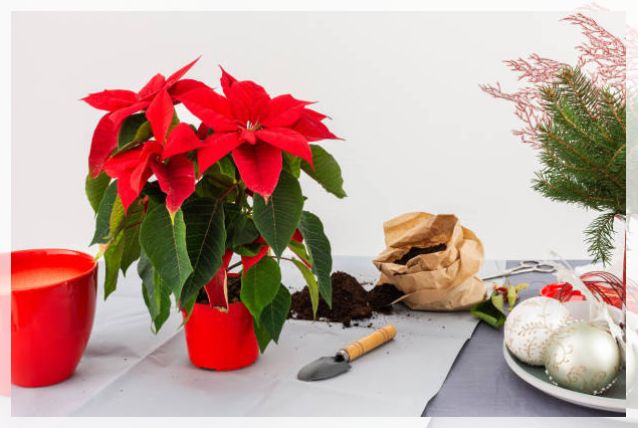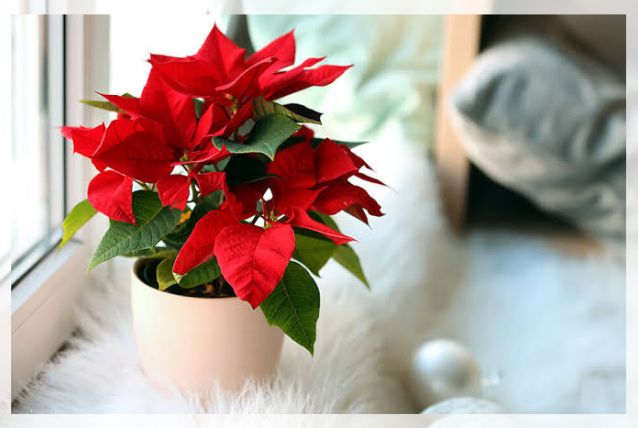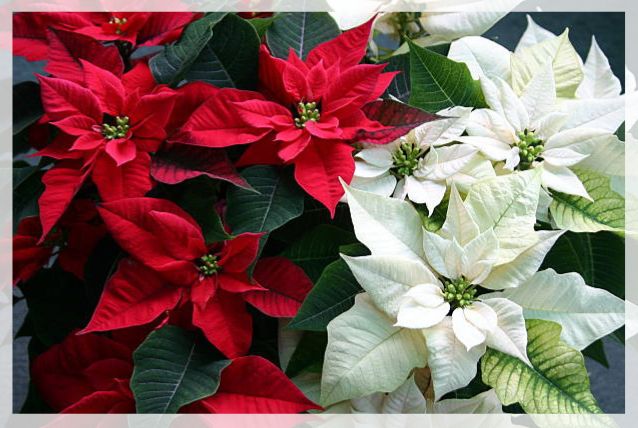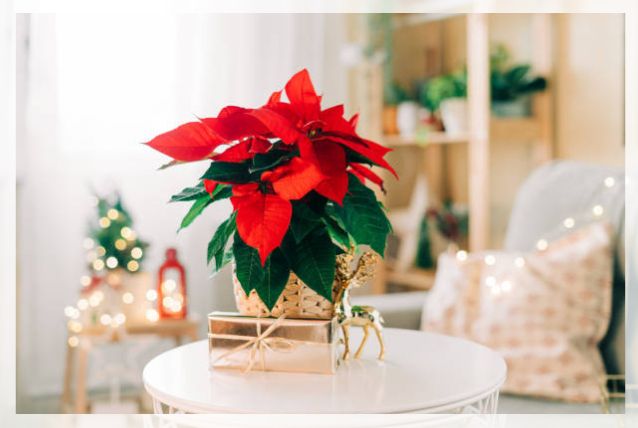How do you take care of Poinsettia Plant all year round?
Poinsettias Plant is a finicky short-day plant that will need certain growing requirements to retain its Christmas blooms.
With proper care, your holiday poinsettia plant will continue to bloom or at least remain attractive for weeks to come.
You will need enough light, water, and temperature conditions for your plant to thrive.
During holidays when they are in full bloom, they often enjoy semi-cool, humid locations in bright, indirect sunlight with enough moisture.
Moreover, you will need to water the poinsettia plant thoroughly, making sure that you do not drown the plant.
In the same way, it is important to avoid letting them sit in water-filled saucers as it can lead to root rot.
How can you take care of Poinsettia Plant?
Keep on reading.
Poinsettia Plant
Poinsettia Plant is native to Mexico and is a perennial shrub.
In most cases, gardeners grow them as annuals for winter holiday display, however, you can also choose to grow them as perennial garden shrubs.
You can do this in regions where winter temperature tends to remain above 50 degrees Fahrenheit.
It is important to note that the familiar red species has also been joined by even flashier hues due to hybridizations.
These have expanded the range of colors from scarlet to white, cream, salmon, yellow, and pink.
The bloom of the poinsettia plant is a cluster of yellow flowers that are surrounded by large often red floral bracts, which are modified leaves.

This plant is also popular as Mexican flameleaf.
Many gardeners force this plant to bloom in time for the holiday season and they need certain care to look their best into the new year and beyond.
In contrast to a popular myth, these plants are not seriously toxic to people or pests.
At most, these can be mildly toxic to cats and dogs who inject plant material.
Learn more about Poisonous Plants for Pets here.
Quick Facts about Poinsettia Plant
Some quick facts about the Poinsettia plant are:
| Common Name | Poinsettia, Mexican flameleaf, Christmas star |
| Botanical Name | Euphorbia pulcherrima |
| Family | Euphorbiaceae |
| Plant Type | Shrub |
| Mature Size | 3–10 ft. tall, 3–7 ft. wide |
| Sun Exposure | Full, partial |
| Soil Type | Loamy, well-drained |
| Soil pH | Neutral, acidic |
| Bloom Time | Winter |
| Flower Color | Yellow |
| Hardiness Zones | 9–11 (USDA) |
| Native Area | Mexico |
| Toxicity | Toxic to pets |
Learn more about Pet-Friendly Gardens! here.
Poinsettia Plant Care
It is important to note that you do not throw away or discard your poinsettia plant in January as you can keep it healthy and vigorous throughout the year with the right care.
The trick is to provide your plant with enough filtered sun, warmth, and water.
As a result, your plant with thrive.
Moreover, if you are motivated and follow a regimen of specific care, your plant may also rebloom new holiday season.
If you choose to grow your plants as landscape shrubs in warm climates, they will need a sunny spot and well-draining soil.
Frequent pinching back of the stem tips to make sure of seasonal color in winter.
Light and Soil Requirements
You will need to place your Poinsettia plant in bright, diffused sunlight.
So make sure to place your plant near a sunny window so that it receives at least 6 to 8 hours of diffused light per day.
Though your plant will survive with a few hours of light, it will not grow as vigorously or as long-lived otherwise.

Make sure to be aware that exposure to direct sunlight can burn the bracts and leaves of your plant.
Although you can purchase already potted poinsettia from a garden center or nursery if you are planting or replanting them, make sure to choose a well-draining peat-based potting soil
In warm climates, where the zones are 9 to 22, you can plant them into the landscape, where they grow best in a well-drained, acidic to neutral soil.
Water, Temperature, and Other Requirements
It is important to water your poinsettia plant whenever the soil feels dry to the touch.
Make sure to saturate the soil until the water runs through the drainage holes in the bottom of your pot.
However, make sure to never let your plant sit in the water.
If you wrap the pot in decorative foil, make sure to poke a few holes through the bottom to allow an excess way to drain.
One of the quickest ways to kill this plant is to overwater it, and wilting leaves and rotted plants often are a sign of overwatering.
To keep your poinsettia plant in bloom as long as you can, make sure to maintain a temperature of 65 to 75 degrees Fahrenheit during the day.
A slight reduction in temperature at night will not hurt the plant.
However, cold drafts where you allow the leaves to touch a cold window or a lack of enough or adequate light can injure the leaves.
Moreover, this can cause premature yellowing and leaf drop.
It is important to note that lack of humidity during dry seasons especially during winter is an ongoing problem for a lot of houseplants, including poinsettia.
If your home is dry, you can invest in a small space humidifier to increase humidity levels in the area surrounding your plant.
Make sure to avoid fertilizing your plant during the blooming season.
When you keep your plant throughout the year, you can fertilize the plant in the spring at half-strength when there is no growth, but not until then.
You will need to feed your plant every four weeks until the plant is re-established.
Getting Poinsettia Plant to Rebloom
If you want to grow poinsettia throughout the year and force blooming the next holiday, you will need to follow a very specific process throughout the year.
It is important to note that achieving rebloom is not an easy process, so don’t be dishearted if you do not succeed on your first try.
Follow the schedule below for the best results:
December to Early Spring: Water your plant and keep them moist but not soaked.
Then at the beginning of the early spring follow:
- decrease watering gradually and allow the soil to dry out between waterings
- make sure that you are careful that the stem of your plant does not begin to shrivel, as this can be a sign of stress or your plant is dying
- in a week or two, when the plant acclimates to this drying process, move it to a cool spot like a basement or heated garage
- keep the temperature around 60 degrees Fahrenheit
May: In May follow the steps below:
Cut the stems back to about 4 inches and repot your plant in a slightly larger container and fill it with new potting soil.
Then water the plant well and place the newly-potted plant in front of the brightest window you have.
However, make sure that the temperature range is 65 to 75 degrees Fahrenheit.
Once new growth appears, you can begin fertilizing every two weeks with a complete fertilizer.
Summer: During summer, you will need to move your plant outdoors.
Moreover, keep the plant in a partially shaded location and make sure to maintain your watering and fertilizing schedule.
In early July, make sure to pinch back each stem by about one inch to enough for a stout, well-branched plant.
If you do not do it, the plant will grow tall and spindly.
By mid-August, the stem will branch and leaf out.
Then again, pinch or cut back the new stems, leaving 3 to 4 leaves on each shoot. Bring the plant indoors and place it near your brightest window.
October: Poinsettia is a short-day plant which means that its bud set is affected by the length of the daylight.
To rebloom your plant, the poinsettia will need 10 weeks with 12 to 14 hours of absolute darkness per day.
You will need to artificially create these conditions and remain diligent.
At the start of October, do the following:
- keep your plant in complete darkness from 5 p.m. to 8 a.m. as any exposure to light can delay blooming
- use an opaque box or other material to block the light including artificial light
- like a lot of people, you can place them in a closet, however, if any light gets through the crack or if you open and use the closet, the exposure to light will affect the bud set
- move the plant back to the sunny window during the daytime and continue watering and fertilizing.
November and December: During the last week of November, stop the darkness treatment and allow your plant to stay near the window.
You will see flower buds at this point.
Stop fertilizing around mid of December.
Keep watering your plant and treat it the way to did when your first bought it home in bloom.
Moreover, if all goes well, bracts will begin to show color.
Types of Poinsettias
Other than traditional red bracts, newer hybrids are available in a variety of colors like shades of white, cream, yellow, salmon, purple, burgundy, and pink.
It is important to note that some unusual colors like blue are produced using dyes and if the plant reblooms, its bracts will be their natural color.
There are at least 100 different poinsettia cultivators you can choose from.
Some recent favorites along with some long-time standards are:
‘Christmas Eve’: One of the long-time favorites with pure red flowers.
It is popular for its long color season.
‘Plum Pudding’: This one is the first purple hybrid.
‘Alsaka White’: This is a pure white cultivator that blends with red varieties, hence its name.

‘Jingle Bell Rock’: This one is a mixture of cream and bright red with glossy dark green leaves.
‘Candy Cinammon’: This one has dappled pink foliage that makes them appear softer.
‘Golden Glow’: This one is a soft yellow variety that is compact.
Moreover, it is popular as it is more heat tolerant than other forms.
‘Lemon Drop’: This one is a cherry variety with bright yellow bracts.
‘Gold Rush’: This beautiful variety combines shades of pink and gold.
Pruning and Propagating Tips and Techniques
Poinsettia that you grow for a single season will need little pruning other than pinching off faded leaves.
However, when you grow plants for rebloom or transplant them into landscapes in mild climates, you will need to pinch back them frequently during the growing season.
This will help to produce bushier plants.
It is important to note that poinsettia are hybrid plants that do not produce genetically reliable seeds.
So you will need to propagate them by rooting stem cuttings.
You can do this by taking stem cuttings in early summer, as new growth is starting. Here’s how you can do it:
- with sharp pruners, snip 3 to 6-inch tips from new growth
- dip the cut end in powdered rooting hormone, then plant in a small pot filled with a standard commercial potting mix
- enclose the planted cutting in a loosely secured plastic bag to hold in moisture
- then set it in a spot with bright, indirect light, however, out of direct sunlight
- after a month, the cutting will develop roots
- when you notice new leaf growth, remove the plastic bag and continue to grow the rooted cutting, repotting as necessary when it fills its pot
Learn more about Pruning Tips and Techniques
Common Pests and Plant Diseases
Like a lot of houseplants, the poinsettia is susceptible to a number of diseases and pests.
These include:
- fungus gnats
- whiteflies
- thrips
- mealybugs
- powdery mildew

When you notice signs of infestations or illness, you will need to remove the affected part of the plant immediately and treat it with an insecticide or fungicide until all signs of the problem disappear.
Learn more about Neem Oil as an Organic Insecticide here.
Common Problems with Poinsettia Plant
While caring for poinsettia to encourage reblooms, make sure to be on the lookout for the signs of leaf and root rot problems as described below:
Leaves Turning Yellow: Leaves will turn completely yellow or develop yellowness around the veins of lower leaves if the plant is stressed.
There are a number of reasons for yellowing leaves.
These are:
- the plant is not getting enough magnesium
- is not getting enough molybdenum which is an essential trace mineral and needs soil pH to adjust to above 5.5
- you are over-fertilizing the plant
- powdery mildew is starting to form on the leaves and will need a fungicide
- potting mix is too acidic
- you are overwatering the plant, is suffering from low light conditions, or low temperatures
If leaves have small spots with yellow halos, the plant tends to have scabs, which will need a fungicide application.
Stems and Leaves Turning Brown: Brown spots tend to form in a number of places if it has a canker.
Moreover, this may help by removing the affected portions of the poinsettia.
Stems tend to turn brown or black if the plant has root rot.
You will need to remove the infected portions of the plant and try to repot the remaining healthier parts in clan soil and clean pots.
Use sterile gardening tools. Then apply a fungicide to the plant for protection.
Plant Leaves Falling Off: When your plant defoliates, it is not good news and can lead to the death of the plant.
Moreover, this means that your plant has serious canker or severe root rot from being underwatered, overwatered, or overfertilized.
If some leaves are falling, the plant may also need a bit more light.






Leave a Reply